Jeannine Atkins's Blog, page 31
November 4, 2011
Goodbye October, Hello, November
I’m back to my blog, after visiting my daughter to make carrot soup and raspberry muffins and do some ferrying, surviving L.A. traffic. I loved her map to Jamba Juice: a perfect rectangle from her home to a corner, unlike the twisting roads in these parts, but for me it was adventure, with no harm done. I got to see Em’s and her roommate Colleen’s new apartment and meet their new dog and watch lots of movies while Em put on ice packs. On Saturday, Colleen, who works at Barnes and Noble, dressed up as Harry Potter for Story Hour, then came home with complaints of parents who thought their kids should focus on candy, not stories, and were aghast that if they wanted to bring home a book they needed to pay for it. Em and I did some shopping, going into a shoe store the size of a football field, where she still couldn’t find the silver sandals she wanted to complete her Captain America Halloween outfit. Generally it was a fun time to be in L.A., when I’d look around and wonder: is that a costume or --not?
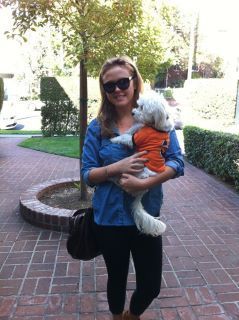
I got back just after the October Northeaster. No harm done at home, though we spent some time without and longer without Internet. I spent Wednesday afternoon among many wanting internet and outlets at Panera Bread, which I’d heard had been breadless the day before. As it was, all the soup was gone. I managed to read my students’ work and get it back, though it was hard to concentrate in the climate of people telling stories about what they’d been doing to stay warm.
Now, yay, for just dogs-with-an-eye-on-squirrel noises, the cat watching my elbow, drinking coffee Peter made me. Power. Internet. Sun, even if my view is of snow below trees with yellow and red leaves.

I got back just after the October Northeaster. No harm done at home, though we spent some time without and longer without Internet. I spent Wednesday afternoon among many wanting internet and outlets at Panera Bread, which I’d heard had been breadless the day before. As it was, all the soup was gone. I managed to read my students’ work and get it back, though it was hard to concentrate in the climate of people telling stories about what they’d been doing to stay warm.
Now, yay, for just dogs-with-an-eye-on-squirrel noises, the cat watching my elbow, drinking coffee Peter made me. Power. Internet. Sun, even if my view is of snow below trees with yellow and red leaves.
Published on November 04, 2011 07:42
October 24, 2011
Real Writers
A brave writer recently emailed me to ask if she thought she should give up. She’d been noticing that others seemed more sure of their visions and voices, and wondered if she might be some sort of fraud to even attempt to keep up. Did I have advice?
I write, teach writing, and review books now and then, so it’s not altogether surprising someone might think I could tell the difference between a real writer and someone who’s faking it. But of course I don’t have a clue. I assured her that wondering if your words have any value, or of feeling surrounded by people who seem so much more secure, can hit any of us at any time. The best we can learn is that it’s transient, part of moving into any sort of new and unstable ground or sandpits. Where the most imaginative writing might grow. The rising of these fears is part of the process. And like all such fears, probably best to say hello, then gently show them to the door.
Peter and I recently met James Sturm who oversees the Center for Cartoon Studies in White River Junction, Vermont. Speaking of incoming students, he dipped his hand into a carton – he orders the paperbacks that way – of Art and Fear: Observations on the Perils (and Rewards) of Artmaking. This slender book is required reading for those studying words and pictures at this school. Other colleges might pick up on this idea, as the book is one you can read over and over, and find new wisdom about the creative process. Or maybe places that teach art or writing should offer courses in Insecurity 101 or Advanced Anxiety. Meanwhile, muddling through doubts is what happens in the corridors with classmates, in hallways at writer’s conferences, or over cups of coffee and computers with friends.
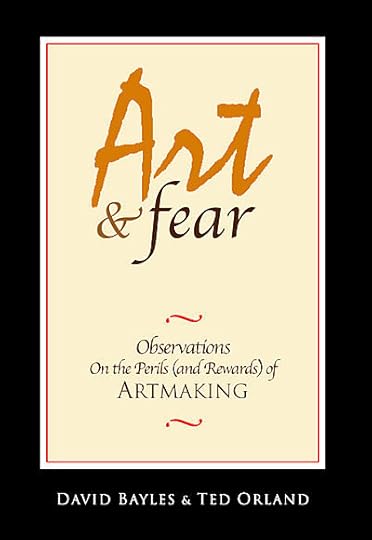
Many of us cry at critiques that feel harsh, or rejections that seem unfair. It’s good to find consolation among others who’ve been there or are there. And good to check in and decide how much crying is too much, and is there a way to change its course. How do you separate criticism of your work from criticism of your self? If anybody knows the trick, please share! All I know is that time can do some healing. So I advise muttering, endangering no life forms, and getting a good night’s sleep. And reminding people that none of us are alone.
I write, teach writing, and review books now and then, so it’s not altogether surprising someone might think I could tell the difference between a real writer and someone who’s faking it. But of course I don’t have a clue. I assured her that wondering if your words have any value, or of feeling surrounded by people who seem so much more secure, can hit any of us at any time. The best we can learn is that it’s transient, part of moving into any sort of new and unstable ground or sandpits. Where the most imaginative writing might grow. The rising of these fears is part of the process. And like all such fears, probably best to say hello, then gently show them to the door.
Peter and I recently met James Sturm who oversees the Center for Cartoon Studies in White River Junction, Vermont. Speaking of incoming students, he dipped his hand into a carton – he orders the paperbacks that way – of Art and Fear: Observations on the Perils (and Rewards) of Artmaking. This slender book is required reading for those studying words and pictures at this school. Other colleges might pick up on this idea, as the book is one you can read over and over, and find new wisdom about the creative process. Or maybe places that teach art or writing should offer courses in Insecurity 101 or Advanced Anxiety. Meanwhile, muddling through doubts is what happens in the corridors with classmates, in hallways at writer’s conferences, or over cups of coffee and computers with friends.

Many of us cry at critiques that feel harsh, or rejections that seem unfair. It’s good to find consolation among others who’ve been there or are there. And good to check in and decide how much crying is too much, and is there a way to change its course. How do you separate criticism of your work from criticism of your self? If anybody knows the trick, please share! All I know is that time can do some healing. So I advise muttering, endangering no life forms, and getting a good night’s sleep. And reminding people that none of us are alone.
Published on October 24, 2011 07:10
October 18, 2011
The Brattleboro Literary Festival
I wish I could have gotten to more of the event-packed Brattleboro Literary Festival last weekend, but I enjoyed two talks in the Brattleboro Museum and Art Center on a lovely Sunday in Vermont.
Salley Mavor showed us the first picture book she made when she was eight (her mother, an artist and art teacher, saved her work), with scraps of fabric stapled onto paper. Later at Rhode Island School of Design, she started a business making pins, work which caused a teacher to suggest that she might put away her paintbrushes and forge ahead with needle and thread. Salley didn’t want to make realistic art, but wanted something real in it. She went on to make three dimensional objects and designs for magazines. She stitched dolls, which she put in frames and called fabric reliefs, developing them with more motion and a sense of engagement in a world of stylized trees, animals, and houses. The Way Home, her first book for children, took about eight years – which Salley said might be average for a first book -- and was published twenty years ago.
I love Pocketful of Posies, which recently won awards from the Horn Book and elsewhere (and I blogged about here, but one of my favorite books remains her Mary Had a Little Lamb. Besides stitching the characters, Salley used real straw, stones, and a bit of an old shingle. The latches are hooks and eyes, and she did the knitting that’s on Mary’s mother’s lap. When she told us that the lamb was all made of French knots, an appreciative gasp rose from the craft loving audience. (please click on the image to see it whole).

We also got a preview of the cover Salley made for the January issue of the Horn Book. Here’s just one of the little people you can expect to see (and use the link above to see more on Salley’s blog, along with the pretty silver bowl she was given as a prize). I can’t wait!

While people lined up to buy books, museum staff got ready for the next speakers. Ken Burns who has produced and directed award-winning documentaries including The Civil War and The National Parks: America’s Best Idea was talking with his friend, David Blistein They’d met about forty years ago when Ken was at Hampshire College and David at Amherst. The talk titled Waking the Dead celebrated their friendship as it was founded around many conversations about how the power of the past influences who we are now. Ken Burns said that most of us have heard that because we don’t know history, we repeat the past. Yet members of Congress and others know history, yet still repeat it.

David Blistein, who read from his contemporary novel peopled with characters from history, posited that the problem is more that we don’t truly feel our history, which condemns us to repeat it. Ken asked him about his writing process. Did he read and then the characters seem to take on or over the story? Or did he read, then engage in life, and find the characters coming back? Of course there was no short answer, or if there was I missed it, while asking the question of myself. And finding quite a hodgepodge.
What an inspiring afternoon.
Salley Mavor showed us the first picture book she made when she was eight (her mother, an artist and art teacher, saved her work), with scraps of fabric stapled onto paper. Later at Rhode Island School of Design, she started a business making pins, work which caused a teacher to suggest that she might put away her paintbrushes and forge ahead with needle and thread. Salley didn’t want to make realistic art, but wanted something real in it. She went on to make three dimensional objects and designs for magazines. She stitched dolls, which she put in frames and called fabric reliefs, developing them with more motion and a sense of engagement in a world of stylized trees, animals, and houses. The Way Home, her first book for children, took about eight years – which Salley said might be average for a first book -- and was published twenty years ago.
I love Pocketful of Posies, which recently won awards from the Horn Book and elsewhere (and I blogged about here, but one of my favorite books remains her Mary Had a Little Lamb. Besides stitching the characters, Salley used real straw, stones, and a bit of an old shingle. The latches are hooks and eyes, and she did the knitting that’s on Mary’s mother’s lap. When she told us that the lamb was all made of French knots, an appreciative gasp rose from the craft loving audience. (please click on the image to see it whole).

We also got a preview of the cover Salley made for the January issue of the Horn Book. Here’s just one of the little people you can expect to see (and use the link above to see more on Salley’s blog, along with the pretty silver bowl she was given as a prize). I can’t wait!

While people lined up to buy books, museum staff got ready for the next speakers. Ken Burns who has produced and directed award-winning documentaries including The Civil War and The National Parks: America’s Best Idea was talking with his friend, David Blistein They’d met about forty years ago when Ken was at Hampshire College and David at Amherst. The talk titled Waking the Dead celebrated their friendship as it was founded around many conversations about how the power of the past influences who we are now. Ken Burns said that most of us have heard that because we don’t know history, we repeat the past. Yet members of Congress and others know history, yet still repeat it.

David Blistein, who read from his contemporary novel peopled with characters from history, posited that the problem is more that we don’t truly feel our history, which condemns us to repeat it. Ken asked him about his writing process. Did he read and then the characters seem to take on or over the story? Or did he read, then engage in life, and find the characters coming back? Of course there was no short answer, or if there was I missed it, while asking the question of myself. And finding quite a hodgepodge.
What an inspiring afternoon.
Published on October 18, 2011 17:27
October 17, 2011
Hugs in Picture Books
I was excited before Picture Book week, in the MFA class I teach at Simmons College at the Carle.
Of course I’d been equally enthusiastic approaching Folk Tales, Novels for Middle Grade Readers, and Poetry, and know I’ll be just as excited before the genres we focus on during weeks ahead. But with a wealth of picture books they might read, I’m not going to say my selection was random, but… I couldn’t include every book I love. So my hands moved somewhat freely as I looked for variety on the syllabus and shut my eyes against what I’d have to leave out.
During class, I went over some of what makes a great picture book, and the students responded to what worked for them in the reading. And as this happened, I noticed a theme in resolutions. If you don’t want spoilers, stop here. Some students, like me, were swept away by City Dog, Country Frog by Mo Willems and enjoyed the double story for parents and children in Knuffle Bunny, which ends with Trixie hugging her lost-then-found bunny.
[image error]
We discussed the spare text of No, David! by David Shannon, and how the mayhem ends with that round head being snuggled within his mom’s arms.
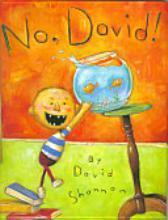
Smoky Night by Eve Bunting, illustrated by David Diaz gave us a somber look at a divided neighborhood, with the last page showing two once unfriendly cats tangled together.
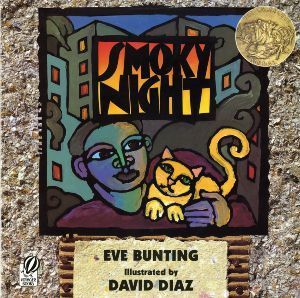
Most were charmed, as my daughter seemed to be, years ago, by Don Freeman’s Corduroy. A lonely stuffed bear sets out in search of a lost button, while a girl doesn’t let no stand in her way to the bear with a missing button she loves. They end up together on the last page with,.. you guessed it.
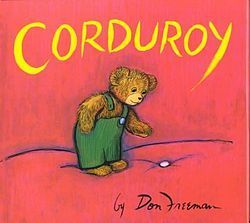
Now as my students write a picture book text for next week, I’ll be watching to see how many conclude with hugs. Or perhaps the other classic ending. We read Good Night, Moon, which ends with a tucked-in bunny, Where the Wild Things Are, which ends with Max standing by his bed, and Make Way for Ducklings, with the family about to go to sleep. What are your favorite endings?
Of course I’d been equally enthusiastic approaching Folk Tales, Novels for Middle Grade Readers, and Poetry, and know I’ll be just as excited before the genres we focus on during weeks ahead. But with a wealth of picture books they might read, I’m not going to say my selection was random, but… I couldn’t include every book I love. So my hands moved somewhat freely as I looked for variety on the syllabus and shut my eyes against what I’d have to leave out.
During class, I went over some of what makes a great picture book, and the students responded to what worked for them in the reading. And as this happened, I noticed a theme in resolutions. If you don’t want spoilers, stop here. Some students, like me, were swept away by City Dog, Country Frog by Mo Willems and enjoyed the double story for parents and children in Knuffle Bunny, which ends with Trixie hugging her lost-then-found bunny.
[image error]
We discussed the spare text of No, David! by David Shannon, and how the mayhem ends with that round head being snuggled within his mom’s arms.

Smoky Night by Eve Bunting, illustrated by David Diaz gave us a somber look at a divided neighborhood, with the last page showing two once unfriendly cats tangled together.

Most were charmed, as my daughter seemed to be, years ago, by Don Freeman’s Corduroy. A lonely stuffed bear sets out in search of a lost button, while a girl doesn’t let no stand in her way to the bear with a missing button she loves. They end up together on the last page with,.. you guessed it.

Now as my students write a picture book text for next week, I’ll be watching to see how many conclude with hugs. Or perhaps the other classic ending. We read Good Night, Moon, which ends with a tucked-in bunny, Where the Wild Things Are, which ends with Max standing by his bed, and Make Way for Ducklings, with the family about to go to sleep. What are your favorite endings?
Published on October 17, 2011 05:27
October 13, 2011
Stephanie Cowell reading Claude and Camille
I like reading novels with art settings and who doesn’t want to learn more about Paris during the Impressionist era? I happened to be reading Claude and Camille by Stephanie Cowell when Peter saw that she’d be giving a talk titled Searching for Monet last Sunday at the Sterling and Francine Clark Art Museum as part of the Windows on the Past series.
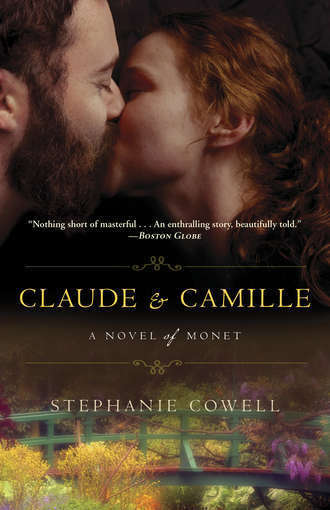
It was great to hear her speak of sources of inspiration and ways she used letters – not many of Camille’s, who died young – and paintings, finding them a context. We got to see wonderful slides, like this one of Claude Monet’s painting of his first wife, Camille, when she was nineteen.
[image error]
And here is Monet at twenty-five– perhaps as fetching as the more familiar photos we see of him in the Giverney gardens when he was in his eighties.
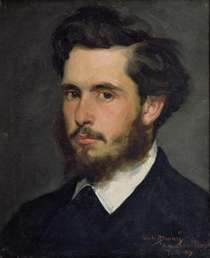
I especially enjoyed the beginning of Claude and Camille, when Monet, son of shopkeeper, began doing caricatures, then moved to Paris where Auguste Renoir, Camille Pissarro, and Frederic Bazille, formed a supportive community for each other. In fact, Stephanie Cowell told us a painting that Bazille did of some of the friends was a big inspiration for her novel. As its title suggests,the book shows the ups and downs, pushes and pulls of a marriage, under the stresses of poverty and differences, though my favorite parts were about painting and a poignant piece of history glimpsed when Paris was cut off from the rest of the country during the war in 1870. I liked the framework she set with the water lilies, shown as a way that Monet looked back, perhaps trying to recreate the beauty of his young wife. She also structured time using some musical terms: she told us she’d been an opera singer for twenty years, and an early novel is Marrying Mozart. She even an old French ballad for us.
Peter took this photo of us when she signed a book.

Next I’ll be reading Stephanie’s blog, the Everyday Lives of French Impressionists, with more suggestions of books to read. Monet’s Table? Yum. And I just picked up Light, by Eva Figes, which she recommended: a short novel about one day in Monet’s later years in the gardens.

It was great to hear her speak of sources of inspiration and ways she used letters – not many of Camille’s, who died young – and paintings, finding them a context. We got to see wonderful slides, like this one of Claude Monet’s painting of his first wife, Camille, when she was nineteen.
[image error]
And here is Monet at twenty-five– perhaps as fetching as the more familiar photos we see of him in the Giverney gardens when he was in his eighties.

I especially enjoyed the beginning of Claude and Camille, when Monet, son of shopkeeper, began doing caricatures, then moved to Paris where Auguste Renoir, Camille Pissarro, and Frederic Bazille, formed a supportive community for each other. In fact, Stephanie Cowell told us a painting that Bazille did of some of the friends was a big inspiration for her novel. As its title suggests,the book shows the ups and downs, pushes and pulls of a marriage, under the stresses of poverty and differences, though my favorite parts were about painting and a poignant piece of history glimpsed when Paris was cut off from the rest of the country during the war in 1870. I liked the framework she set with the water lilies, shown as a way that Monet looked back, perhaps trying to recreate the beauty of his young wife. She also structured time using some musical terms: she told us she’d been an opera singer for twenty years, and an early novel is Marrying Mozart. She even an old French ballad for us.
Peter took this photo of us when she signed a book.

Next I’ll be reading Stephanie’s blog, the Everyday Lives of French Impressionists, with more suggestions of books to read. Monet’s Table? Yum. And I just picked up Light, by Eva Figes, which she recommended: a short novel about one day in Monet’s later years in the gardens.
Published on October 13, 2011 07:21
October 11, 2011
Change is Coming
The weekend was warm enough to write on the porch, which made it great. But I did think of leaves beyond, and called my friend, Jess, to see if she wanted to hike up a (small) mountain.
“How about next weekend?” she replied. “I’m writing with a Thursday deadline.”
When I told her I had plans for next weekend, she said, “Argh, I don’t know. Really I’m sitting before my computer not getting much done. Feeling it’s a holiday, everyone else is out doing things.”
“Want to come here and write together, then take a break on the mountain?”
Which is what we did, fueled by iced lattes Peter brought to the porch. Work got done and spirits raised. The view from the mountain was spectacular, though I didn’t bring my camera. Instead, here’s a spot that caught Peter’s and my eyes the day before.

In the evening I worked a bit on a new blog host at wordpress, which I hope doesn’t have the problems Livejournal has been posing these past months. The site’s coming along, and I’ll make a moving announcement soon, though I plan to keep this one going. Where I’ve had so much fun and met so many great friends, who I hope will tag along. The house isn’t quite ready – who’s ever ready for change? -- but for a peek, and if you care to bookmark, go to the new Views from a Window Seat. Suggestions are welcome!
Published on October 11, 2011 05:46
October 7, 2011
Cupboard Doors and Poetry
Last night I had dinner with friends, one of whom is moving. She told us that so far she has a grip on packing well-labeled boxes, though she knows soon she’ll come to tossing things randomly into IKEA bags. The other friend said she’d heard a good way to pack is by labeling according to where stuff came from. That is the cupboard left of the stove, or desk top drawer. Places you might visualize, and think of going to in a new place. I can see where starting from the outside would be handy, and of course, it’s how most poems start, too. From a simple wooden door or shelf or .. say, a leaf or the surface of a pond. Let the rummaging come later.
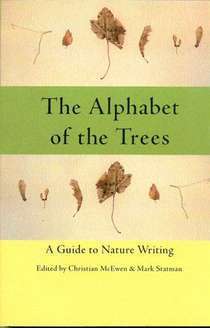
I made this connection this morning when reading “Pen and Paper and a Breath of Air,” an essay by poet Mary Oliver in The Alphabet of the Trees: A Guide to Nature Writing edited by Christian McEwen and Mark Statman, which is filled with great poems and inspiration. In this essay, Mary Oliver writes of the small notebooks she’s carried for more than thirty years in her back pocket. These don’t hold poems, but the beginnings, often, amidst quotes, shopping lists, and recipes. There are notes on birds, plants, animals slants of light she sees while hiking. She writes, “The words do not take me to the reason I made the entry, but back to the felt experience, whatever it was. This is important. I can, then, think forward again to the idea – that is, the significance of the event – rather than back upon it. It is the instant I try to catch in the notebooks, not the comment, not the thought. And, of course, this is so often what I am aiming to do in the finished poems themselves.”
Her essay continues with examples of ordinary things which observed closely reveal the marvelous. Last night my class, who are writing across the genres, tried composing some poems, and perhaps the most popular entrée for some was writing from pictures my husband had taken outdoors. As people read some of these aloud, I glimpsed something lovely in the first drafts, but also had a sense of something yet to be explored. I suggested, Stick with that. A door had been chosen, and we got peeks of something complicated beneath. Listening to that door, looking longer, will deepen the vision into poems that may take us all from frogs, ponds, and grasses into wild new places.
For the Poetry Friday roundup, please visit Great Kids Books,

I made this connection this morning when reading “Pen and Paper and a Breath of Air,” an essay by poet Mary Oliver in The Alphabet of the Trees: A Guide to Nature Writing edited by Christian McEwen and Mark Statman, which is filled with great poems and inspiration. In this essay, Mary Oliver writes of the small notebooks she’s carried for more than thirty years in her back pocket. These don’t hold poems, but the beginnings, often, amidst quotes, shopping lists, and recipes. There are notes on birds, plants, animals slants of light she sees while hiking. She writes, “The words do not take me to the reason I made the entry, but back to the felt experience, whatever it was. This is important. I can, then, think forward again to the idea – that is, the significance of the event – rather than back upon it. It is the instant I try to catch in the notebooks, not the comment, not the thought. And, of course, this is so often what I am aiming to do in the finished poems themselves.”
Her essay continues with examples of ordinary things which observed closely reveal the marvelous. Last night my class, who are writing across the genres, tried composing some poems, and perhaps the most popular entrée for some was writing from pictures my husband had taken outdoors. As people read some of these aloud, I glimpsed something lovely in the first drafts, but also had a sense of something yet to be explored. I suggested, Stick with that. A door had been chosen, and we got peeks of something complicated beneath. Listening to that door, looking longer, will deepen the vision into poems that may take us all from frogs, ponds, and grasses into wild new places.
For the Poetry Friday roundup, please visit Great Kids Books,
Published on October 07, 2011 10:05
September 26, 2011
The Burlington Book Festival
 Here’s a view of Main Street Landing by Lake Champlain where a lot of us talked about words at the Burlington Book Festival. Tanya Lee Stone and I gave a presentation on nonfiction for young readers. We talked about research, falling in love with our subjects, and ways we collaborate with illustrators, which often is mostly as a historical reference provider.
Here’s a view of Main Street Landing by Lake Champlain where a lot of us talked about words at the Burlington Book Festival. Tanya Lee Stone and I gave a presentation on nonfiction for young readers. We talked about research, falling in love with our subjects, and ways we collaborate with illustrators, which often is mostly as a historical reference provider.
Soon we joined Jo Knowles
![[info]](https://i.gr-assets.com/images/S/compressed.photo.goodreads.com/hostedimages/1380451598i/2033940.gif) joknowles
for a panel about writing for teens (if you click on the picture, you can see me, as well as, below, Kate) responding to great questions. We revealed the lengths of time between the dream of writing and publication. And who feels compelled to write every day (that would be me, even for fifteen minutes) and who is less compulsive. We discussed the ways revision teaches us about theme and adds layers – Jo changing points of view and tenses from one draft of a novel to the next, Tanya and I often starting a longer book as a picture book, distilling, which points us toward the essence of what we have to say, while we go on to expand the scope. My husband, Peter, took pictures -- thanks! --including this one of Jo encouraging a young writer.
joknowles
for a panel about writing for teens (if you click on the picture, you can see me, as well as, below, Kate) responding to great questions. We revealed the lengths of time between the dream of writing and publication. And who feels compelled to write every day (that would be me, even for fifteen minutes) and who is less compulsive. We discussed the ways revision teaches us about theme and adds layers – Jo changing points of view and tenses from one draft of a novel to the next, Tanya and I often starting a longer book as a picture book, distilling, which points us toward the essence of what we have to say, while we go on to expand the scope. My husband, Peter, took pictures -- thanks! --including this one of Jo encouraging a young writer. 
I listened in to part of the panel about books for middle readers. From the left, Cynthia Lord
![[info]](https://i.gr-assets.com/images/S/compressed.photo.goodreads.com/hostedimages/1380451598i/2033940.gif) cynthialord
,Erica S. Perl (When Life Gives You O.J.), Linda Urban (Hound Dog True) Sarah Albee (Poop Happened!) Ammi-Joan Pacquette (Nowhere Girl), Sarah Aronson (Beyond Lucky), Kate Messner all told some of the stories behind the stories.
cynthialord
,Erica S. Perl (When Life Gives You O.J.), Linda Urban (Hound Dog True) Sarah Albee (Poop Happened!) Ammi-Joan Pacquette (Nowhere Girl), Sarah Aronson (Beyond Lucky), Kate Messner all told some of the stories behind the stories.The day ended with what was called a super panel, which included those above as well Elizabeth Bluemle http://www.elizabethbluemle.com/ (How Do You Wokka-Wokka?) and Kara LaReau http://karalareau.com/ (Otto: The Boy Who Loved Cars) fielding questions about inspiration, agents, waiting, and discipline. We signed books sold by Phoenix Books and Café www.phoenixbooks.biz. In the corridors we caught up with what are we crossing our fingers about now, or what some really thought about the cover of her book. I met new readers and writers, too. One young writer told me she wrote eight pages in her notebook. “There was so much I didn’t know!”
There’s still a lot I don’t know, but as years pass there’s a little bit less. And today, I imagine this writer opening her notebook with its ribbon marker filled both with eight pages of revealed mysteries as well as empty pages which are the most important of all. We may both be looking at blank paper or screens, trying to make something new from what we don’t know and are excited to find out.
Published on September 26, 2011 11:14
September 19, 2011
Celebrating Masha Rudman's Contributions to Children's Literature
Masha Rudman taught for more than forty years in the UMass-Amherst School of Education. I knew her as the force behind the Perspectives in Children’s Literature conference, which ran for 24 years. Upon recently retiring, she donated her collection of more than 8,000 books for children to the W.E.B. Du Bois Library, asking that they’d be kept available for circulation. They’ve been arranged in accord with Masha’s textbook, Children’s Literature: An Issues Approach, with categories such as our green and threatened earth, gender, special needs, and many by heritage. You can search the Masha Kabakow Rudman Issues in Children’s Literature Collection here.
I’ve always sent students to the 11th floor of tall library (“get out of the elevators, and head away from the campus center, toward the football fields/sunset.”) But now there is so much more. Before Saturday’s program honoring Masha and her gift, many people checked out the stacks.

I said hello to Barbara Elleman, writer, educator, and founder of Book Links, an amazing resource for teachers, with Rosemary Agoglia, curator of education at the Eric Carle Museum of Picture Book Art. (whose beautiful face I'm sorry you'll have to click on the photo to see. LJ is being uncooperative again).

It was wonderful to hear Masha reminisce a bit and read from some picture books.

Speakers thanking Masha included librarians, professors, writer Jane Yolen via Skype, and Jacqueline Woodson, another writer whose thirty-plus books are represented in the collection. She spoke of how books stay with us, and recited from memory the text of her picture book, THE OTHER SIDE.

Her words of hope for a changed world precisely fitted Masha Rudman’s spirit.
Published on September 19, 2011 06:32
September 12, 2011
Celebrating The RelaxAbility Handbook
Jessica Sarfaraz Berger was my friend before I took some of her yoga classes, so I wasn’t surprised by her positive and gentle approach to calmness and fitness. Now she’s put some of what she’s learned in twenty-five years of helping people feel better as a registered nurse, a personal fitness instructor, and teacher of yoga and dance into a book called The RelaxAbility Handbook: 66 Easy-to-Use Stress Reduction Techniques for All Walks of Life.
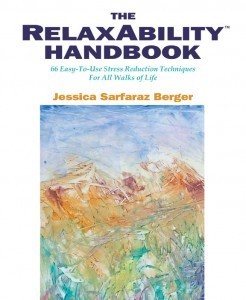
In a party to celebrate the launch of a book she not only wrote but published herself, with the help of some friends and especially her husband, Dan Berger, there was a lot of laughter. Here's Jess (on the right) with big-hearted hosts, Aaron and Debra Vega who oversee and teach at Vega Yoga studio in Holyoke, MA. (and if you click on the photo, you can see Dan beside Jess. Sorry about that, Dan; the formatting gods are eluding me today.)
[image error]
There are short, clear methods to reduce stress quickly. Some techniques draw more from the mind, some from imagination, and some from the body. Some seem serious and some are designed to elicit that wonderful stress relief of laughter. Jess offers ways to cope with insomnia, pain, chronic anxiety as well as daily sorts of stress through doing simple exercises (I’m a fan of Legs Up the Wall), making art, doing meditation, breathing techniques, or chanting: Jess mentions Om, but also Yum. Really there’s something for everyone. Jess suggests that those who think they’ll never repeat a mantra may be doing it all the time, and it’s often a negative one about who we are that was slipped or kind of stabbed into our minds at childhood. Jess sometimes introduces exercises with examples from her life, and mentions a sad lie that she carried around for years. Much better to go with Om, Yum, or Jai! Or get together with friends.

It was fun to meet people who inspired Jess, as she inspires and cheers so many. For book or cd ordering information, please click here.
Published on September 12, 2011 06:31



